Republic of Minerva
"...every square foot of dry land on Earth has been claimed by at least one country or another," writes Andy Newland, who served as Purser aboard the ship "Queen of the Isles II." He goes on to relate how only pieces of land that project at least one foot above high tide can be claimed, according to International Law.[4] Technically, that kept the reefs from being claimed by any other nation, as they were only visible at low tide and disappeared at high tide.
In the early 1970s, a man named Michael Oliver, who was born in Lithuania and immigrated to the US, had become a millionaire via the real estate market. He sought to establish an independent nation based on libertarian principles and hatched a plan to claim the reefs for his project. Through a syndicate of his founding, the Ocean Life Research Foundation, he was able to raise USD $100 million. With these funds, he hired barges to bring sand from Australia in an attempt to raise the level of the reefs above sea level at high tide. He was successful, and his crew then hoisted the flag of the new nation, the Republic of Minerva.
Shortly afterwards, the new republic began minting their own coins and made plans to build a large platform across the reefs onto which dwellings could be constructed. A Declaration of Independence was issued to neighboring nations in the South Pacific. This project was thwarted, however, when the Kingdom of Tonga claimed that the reefs were part of their long-established fishing territory and sent a ship to Minerva. The territory was unoccupied at the time, as no platform, nor dwellings, were yet in existence. The Tongan crew tore down the Minervan flag, however, and issued a proclamation laying claim to the reef, which was upheld by the Pacific Islands Forum, a league of nations in the South Pacific. It is difficult to determine why International Law did not prevail, or perhaps it was never brought to suit in a tribunal.
In my reading about the Republic of Minerva, I learned that it was never recognized as a nation by the global community. Because of this, most sources place quotes around the word "country" when referring to it. That makes me wonder, though — when does a new country actually become a country? When the USA issued its Declaration of Independence, it was not initially recognized by England as a valid nation, but did that make it any less a country? Other similar situations have arisen over the years, such as the curious issue regarding Liberland, another micronation that claims uninhabited land along the Danube River in Europe, not currently claimed by any other nation. Liberland is not recognized by any world powers, but does that make it less a valid "country," or not? Only time, arbitration, and history will determine the answer. For now, though, I will speak of the Republic of Minerva as a country, without the quotes, for the sake of simplicity if nothing else.
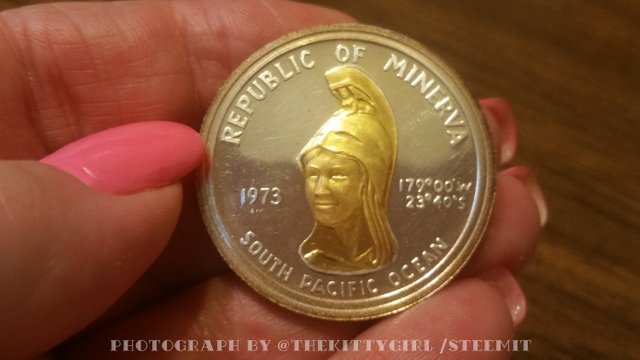
• REPUBLIC OF MINERVA BULLION COIN, PHOTO BY ME •
Since I like quirky things, I was quite excited to have found one of the Minerva Dollar coins for sale online and was able to add it to my collection! To be honest, I was more attracted to it because it depicted a Goddess than any other reason, but the history was a secondary reason as well. I bought the coin on eBay, but online coin shop MontanaRarities.com states that:
The country eventually had their own currency issued, minted at the Letcher Mint in California. Only 10,500 of these coins were minted, and each contains 24 grams of .999 fine silver, and 10 grains (0.648 grams) of 24 ct [sic] (pure) gold.[3]
Since only 10,500 of these were minted, I am probably exceedingly lucky to have found one at a price that I could afford, as I am far from wealthy. Perhaps other collectors are not clamoring after such items of eccentricity?
The obverse (front) of the coin features a portrait of the Roman Goddess Minerva, adorned with 24K gold, which is quite striking against the .999 Fine Silver background. I have never seen a coin with the latitude and longitude of the country issuing the currency, so that is a rather unique feature! Since the Republic of Minerva only lasted for a portion of the year 1972, I am unclear as to why the date "1973" is stamped on the coin rather than "1972" when the coin was minted. Perhaps 1973 was the earliest year that the founders planned to inhabit the island and were to actually begin using the currency.
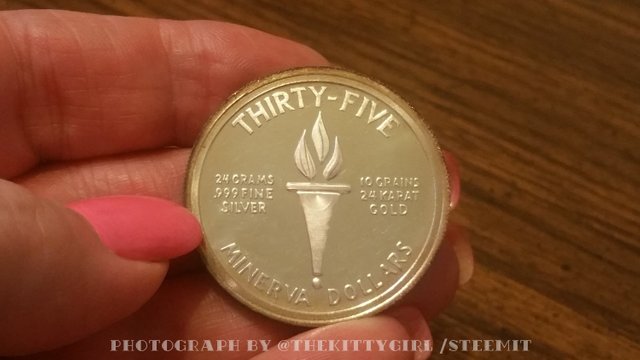
• PHOTO BY ME •
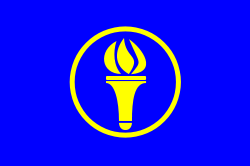
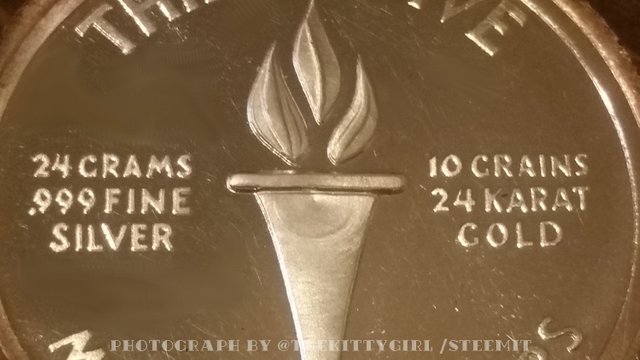
• PHOTO BY ME •
The edge of the coin is reeded, and slightly darker than the rest of the coin; I am not sure why, nor what process they used to tone it that way.
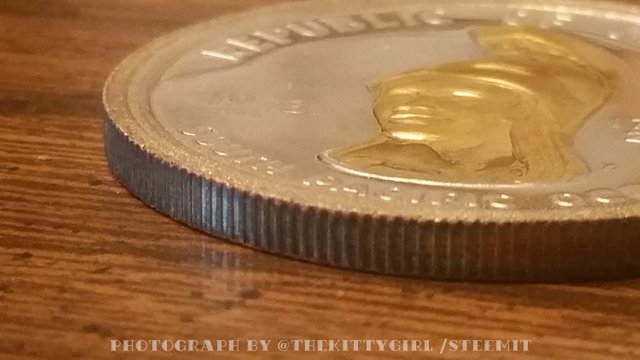
• PHOTO BY ME •
Being interested in geography my entire life, of course, I wanted to see this place on a map! Fortunately, AtlasObscura.com provided a map with the location marked. I modified it slightly to add the name of the place and the latitude and longitude beneath. The red marker shows the location of the Minerva Reefs, and the green marker shows the location of Tonga, 250 nautical miles to the northeast.

• MAP BY GOOGLE, EMBEDDED ON THE ATLAS OBSCURA WEBSITE •
The best website for viewing photos of Minerva is SmithTribeSailing, which has quite a nice photo-journal of a visit to the place. They list it as a good stopover point between Tonga and New Zealand. Check out their pics!
• WOMAN STANDING ON THE MINERVA REEF, SOURCE: SmithTribeSailing •
 😊
😊SOURCES
1 AtlasObscura: Republic of Minerva
2 MincronationsWikia: Minerva
3 QueenOfTheIsles: Olavaha & the Republic of Minerva
4 Wikipedia: Minerva (Goddess)
5 Wikipedia: Minerva Reefs / Republic of Minerva


a big hug to @enginewitty for designing the following personal banner for me 🤗





A well written and really interesting post!
I never heard of the Republic of Minerva before. But I know of some other attempts to establish a independant new country - mostly they didn't succeed. Basically it takes other countriess to support the claim, and that is difficult to achieve.
Also, congratulation for aquiring this coin. I wonder what you payed for that. A issue of 10.000 is certainly not much, plus the peculiar background story it has.
The darker colour on the rim could be the normal silver tanning. Perhaps it was on the entire coin and somebody cleaned it. It is difficult to get it out of the grooves though.
Btw., karat and carat are 2 completely different things. Karat measures the purity of gold and is manly used in english speaking countries, but not really for coins.
Generally, they seem to have tried to be different with that coin. 24 grams is more or less 3/4 ozt of silcer, and here they used the common .999 label. But for the gold they used something entirely different. Weird...
But over all it was perhaps for the best that the Republic of Minerva failed. At the very least it would have messed up a coral reef, if it had succeeded. And much likely even worse things may have happened, as they did in other experiments of that kind.
This is delightful and amazing, friend.
A wonderful story about two wonderful coins. Thanks for the knowledge.
Silver and gold? So badass, I'm like box jelly.
Posted using Partiko Android
I had never heard of this but I am intensely interested!! Tis will now become one of the pieces I want to get right along side The NORFED Liberty Dollars. I don't know if you are familiar with these but I think you would love the story as well. I always admire when people try to build from principle even though there are so many that just want principle to die. They were brought to life by Von NotHaus and represented a move back to actual monetary policy. Heres a link if you wanted to check it out
http://www.libertydollar.org/ld/about/intro.htm
Thanks for sharing!!
Seems you got a lovely colection of all the coins....steem on
Posted using Partiko Android
it is amazing read, I never heard that country before, but you serve this valuable information to us. thank for your work @thekittygirl. wish you all the best #steemitbloggers
You sure do like your coins
howdy thekittygirl! amazing story and the coin is beautiful, what an nice one for your collection, this is a wonderful post!